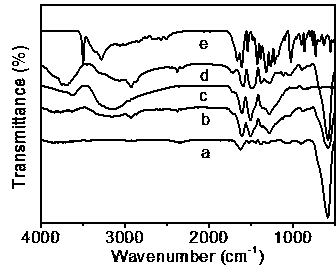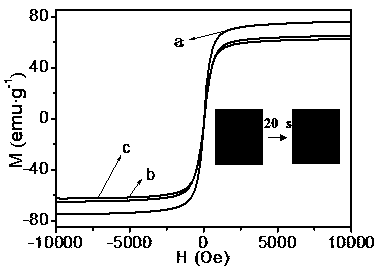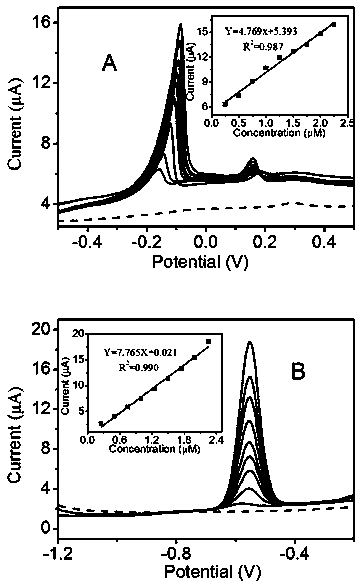Preparation and application of magnetic nano-composite material gamma-Fe2O3/PDA (Polydopamine)-GA (Gallic Acid)
A composite material and magnetic nano technology, applied in the direction of material electrochemical variables, alkali metal compounds, water/sewage treatment, etc., can solve secondary pollution, heavy metal ion detection and adsorption simplification, no effective solution to heavy metal ion detection in water Integration with adsorption and other issues to achieve the effect of improving adsorption capacity, high sensitivity, and low detection offline
- Summary
- Abstract
- Description
- Claims
- Application Information
AI Technical Summary
Problems solved by technology
Method used
Image
Examples
Embodiment 1
[0028] 1. Magnetic nanocomposite γ-Fe 2 o 3 The preparation method of / PDA-GA, its step is as follows:
[0029] (1) Dissolve 0.5 g PVP in 20 mL EG, add 2.5 mmol FeCl to the above mixture 3 ·H 2 O (0.6757 g) and 15 mmol NaAc (1.2304 g) were uniformly dispersed by ultrasonic, then moved to a microwave reactor and kept at 200 °C for 10 h. After cooling to room temperature, the obtained nanomaterials were cleaned with a 3:1 (V / V) ethanol-water mixture, and moved into an oven at 150 °C for 2 h;
[0030](2) 200 mg of dopamine hydrochloride (DA·HCl) was dissolved in 20 mL of Tris-HCl buffer solution with pH=8.5, stirred for 1 h, and recorded as solution 1. Another 100 mg of γ-Fe 2 o 3 It was also dissolved in 20 mL of Tris-HCl buffer solution with pH=8.5, and the solution was uniformly dispersed under the action of ultrasound and stirring, which was recorded as solution 2. Solutions 1 and 2 were mixed and stirred for 6 h. The obtained nanomaterials were cleaned with a 3:1 (V / V...
Embodiment 2
[0038] Take 1 mg γ-Fe respectively 2 o 3 , γ-Fe 2 o 3 / PDA and γ-Fe 2 o 3 / PDA-GA is placed on the weighing paper, and then the weighing paper is folded into a side size of 0.25 cm 2 , moved into a vibrating sample magnetometer to measure the saturation magnetization of these three nanomaterials, and the scanning range of the magnetic field was -10000-10000 Oe. Such as figure 2 It can be seen from the figure that with the introduction of polydopamine and gallic acid, the saturation magnetization of the material gradually decreases (74.8 emu·g -1 →64.8 emu·g -1 →62.4 emu·g -1 ), but γ-Fe 2 o 3 / PDA and γ-Fe 2 o 3 / PDA-GA have basically the same saturation magnetization. The small picture shows that the final product is ultrasonically dispersed in water, and then moved to the side of the magnet. After 20 s, it can be found that the solution becomes clear, indicating that the synthesized material still has strong magnetic properties and is easy to separate.
Embodiment 3
[0040] Prepare 10 mg·L -1 γ-Fe 2 o 3 / PDA-GA aqueous solution, pipette 5 μL of the solution onto the glassy carbon electrode. After the surface of the electrode is dried, respectively with different (A) Cu 2+ and (B)Pb 2+ The concentration (0.25 μM, 0.5 μM, 0.75 μM, 1 μM, 1.25 μM, 1.5 μM, 1.75 μM, 2 μM, 2.25 μM) of HAc / NaAc (0.1M, pH=4.5) buffer is the electrolyte, and the enrichment voltage : -1.2 V; enrichment time: 150 s; amplitude: 25 mV; potential increment: 4 mV; scan range: -1.2-0.5 V. The relationship between the peak current at the peak potential, such as image 3 shown. It can be seen from the figure that as the concentration of metal ions increases, the corresponding corresponding peak current gradually increases, and metal ions still have a high response peak current at low concentrations; it can be seen from the small figure that: fitting The current-concentration curve has better linearity, for Cu 2+ and Pb 2+ The sensitivity reaches 4.679 μA·μM -1 and...
PUM
 Login to View More
Login to View More Abstract
Description
Claims
Application Information
 Login to View More
Login to View More - R&D
- Intellectual Property
- Life Sciences
- Materials
- Tech Scout
- Unparalleled Data Quality
- Higher Quality Content
- 60% Fewer Hallucinations
Browse by: Latest US Patents, China's latest patents, Technical Efficacy Thesaurus, Application Domain, Technology Topic, Popular Technical Reports.
© 2025 PatSnap. All rights reserved.Legal|Privacy policy|Modern Slavery Act Transparency Statement|Sitemap|About US| Contact US: help@patsnap.com



